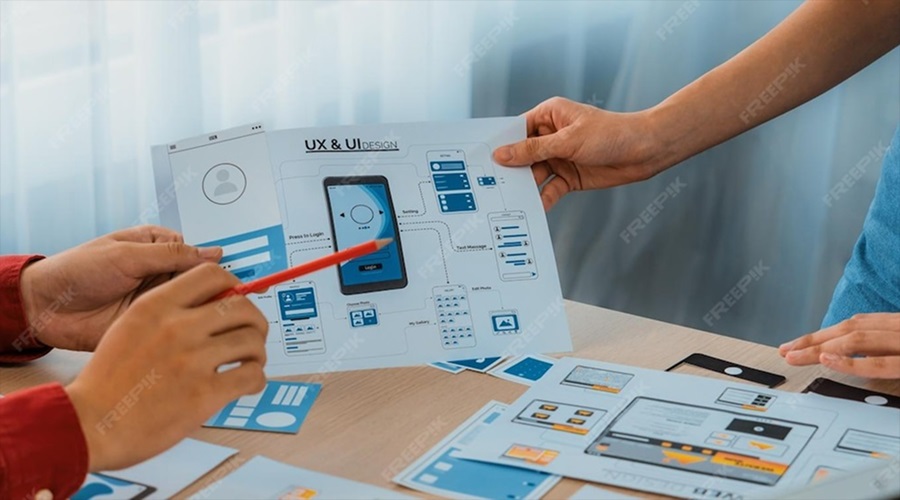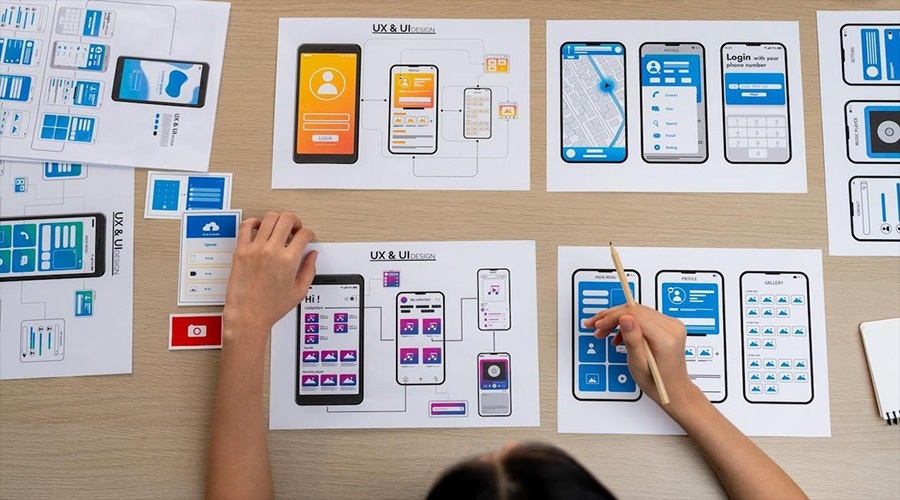
UI/UX design influences customer perceptions about your brand and its usage. A seamless, user-friendly experience builds credibility, enhances interaction and boosts sales. Good design is no longer a luxury in today’s world; it is one of the ultimate business strategies that determines the success or failure of your product in the competitive market. This blog highlights the reasons why UI/UX design (user interface/user experience) has become a game-changer for modern businesses.
Design is not just the way something appears but the way it feels, flows, and works. Users immediately develop opinions when they visit your site or open your application. They make up their mind in seconds, either to remain, to investigate or to move on. That is the strength of UI/UX design.
The modern world moves at a high pace. Customers expect smooth operations, immediate feedback, and easy-to-navigate interfaces. If your product fails to do that, they will get one which does. Companies that decide to invest in considerate UI/UX design not only appear better, but they also do better.
The fact is that good design is not a luxury any more. It’s a necessity. It may transform visitors into customers, and goods into brands that people trust.
So, let’s find out why UI/UX design Service is more important for the success of businesses than ever before, and how businesses can use it as a tactical advantage in this competitive digital world.
1. First Impressions Happen in Seconds
➢ The Power of Visual Connection:
The first thing that users see is the design of your digital platform. An attractive and clean interface instantly creates trust, while clutter or incompatibility drives users away. The initial few seconds determine whether they will be able to explore the page further or leave immediately.
➢ UI Design as Brand Language:
UI design is what your brand looks like in a visual sense, i.e. buttons, colours, fonts, and spacing. When used in a proper manner, it results in a state of clarity and consistency, which are signs of professionalism. Effective Website Design ensures that every visual element communicates your brand values clearly to users.
➢ Designs That Instantly Feel Right:
Take the example of apps, such as Airbnb or Spotify, with their easy-to-follow designs and pleasant design, they are immediately attractive. That’s proper UI design: it should be natural, not forced.
2. UX Design Builds Loyalty, Not Just Traffic
➢ From Visitors to Users:
It is simple to attract traffic, but hard to maintain users. It is here where UX (User Experience) design comes in, as it offers a user a chance to obtain the desired outcomes in the most comfortable and entertaining manner possible.
➢ The Flow That Keeps People Coming Back
Excellent UX ensures that each interaction is smooth. Users can find, buy, or book something fast; they will tend to be more likely to come back. Ease of use builds loyalty.
➢ Experience Over Appearance
Amazon is not known by beauty, but by usability. It has a simple, fast and frictionless UX. That is what brings the customers back and back.
3. Good Design = Better Conversions

➢ The Link Between Design and Business Growth:
Design has a direct relationship with your bottom line. An organised design can direct the user to what they want to do, like sign up, buy or download without feeling lost.
➢ Removing Friction, Increasing Results:
When a user finds it hard to navigate or fill out a form, they will leave it. Magnificent UI/UX eliminates any barriers, and every step becomes easy and natural. Incorporating effective Graphic Design Styles ensures a smoother user journey and higher retention.
➢ Conversions Through Confidence
Clear design is equal to confidence. Whenever users have a clue about where they are going and what they are doing, they will be more ready to act, which will increase sales and satisfaction collectively.
4. Designing for Emotion and Connection
➢ The Feel-Good Factor of Great Design:
Experiences that leave users with a feeling of being comfortable, happy, trusted, or excited are remembered. Those emotions can be achieved through design in terms of tone, visuals, and interaction.
➢ Colours and Psychology in Design:
A gentle blue creates relaxation, whereas vivid red creates haste. Emotional design is the combination of psychology and creativity that helps to make the users feel the intent of your brand.
➢ Empathy-Driven Experiences
Applications such as Duolingo and Notion are successful since they care about the users. They are made to be human-friendly, intuitive and rewarding.
5. Accessibility Expands Your Reach
➢ Designing for Everyone:
Accessibility makes sure your digital product is usable by everyone, including individuals with disabilities. This will include legible fonts, colour contrasts and voice recognition, which are key principles often seen in Minimalist Web Design that focus on clarity and usability for all users.
➢ Inclusive Design Is Smart Design:
In addition to being ethical, accessibility increases your audience. When anyone can access your product without complications, you automatically boost the involvement and confidence.
➢ Staying Ahead with Accessibility Standards:
WCAG and other global accessibility requirements keep you up to date and compliant. Being inclusive is not merely the right thing to do, but it is a smart business move.
6. Speed and Simplicity Drive Engagement
➢ Why Every Second Matters:
Delays are intolerable to the users. The slightest delay of one second will drive them away. Rapid loading and responsive design are essential success factors.
➢ Simplicity Equals Clarity:
Excessive designs confuse users. Straightforwardness assists them in concentrating on the real issues. Neat designs and reduced distraction keep them longer.
➢ Effortless Interactions Build Trust:
Users are in control when working on something that feels natural, such as tapping, scrolling, or checking out. That trust results in repeat interactions and connections.
7. Mobile-First Design: It Is Not Negotiable

➢ The World Is on Mobile:
The majority of users view, shop, and socialise on their mobiles. A mobile-first strategy will guarantee that you go where they already are
➢ Designing for Thumbs, Not Cursors:
Mobile UX is not about reducing desktop layouts, but about how to make it optimal with small screens. Through thoughtful Mobile UX design, the most important thing is bigger buttons, smooth scrolling and gestures.
➢ Seamless Experiences Across Devices:
From smartphones to tablets, people need consistency. A mobile-first design is comfortable on any device.
8. Data-Driven Design for Smarter Decisions
➢ Design Backed by Real Insights:
Contemporary design lives on information. Analytics and user behaviour monitoring will show how individuals can use your product- what they like, what irritates them.
➢ Testing and Iterating with Purpose:
A/B testing assists in perfecting design decisions. You can make improvements that work by making comparisons between layouts, CTAs, or even navigation paths. Integrating Mobile UX Design principles ensures these tests focus on creating user-friendly and efficient interfaces.
➢ Design That Evolves With Users:
When design is dynamic according to data, it adapts to the needs of users. It is not only creative, but it is a strategic development.
9. Brand Identity Through Design

➢ Design as Brand Personality:
Each brand has a character, and design gives it life. Your UI/UX influences the emotions that people have when they are involved with your brand.
➢ Consistency Builds Recognition:
Familiarity is created by the use of the same fonts, colours, and elements across platforms. That acceptance brings about confidence and brand recognition.
➢ Turning Design Into a Signature:
Think of Apple, minimalism, clarity and precision are its identity. That is not by accident; it is a deliberate creation that tells a non-verbal story.
10. The Future of UI/UX Design
➢ Beyond Screens: Into Experiences:
The second chapter of UI/UX Mobile App Design will be a combination of AI, AR, and voice. Design will not be confined to screens anymore; it will enclose people.
➢ Hyper-Personalisation Takes the Lead:
Future designs will be dynamically responsive to user behaviour, tastes and even feelings- generating experiences unique to customers.
➢ Empathy Will Always Be the Core:
Even with the development of technology, empathy will be core. Even the most successful designs will understand people first.
Conclusion
In this digital world, your design is your first impression, your customer service and your brand voice all in one. UI/UX design is not an option anymore, but it is a foundation. It determines the way customers perceive, interact and recall your business. When it is done correctly, it can make ordinary relationships extraordinary.
Investment in design is not just about aesthetics. It is about establishing trust, enhancing interaction, and promoting expansion. Today and in future, the companies prioritising UI/UX will be in the lead as they will be the companies people will love to use, refer to their friends, and repeat the experience.






